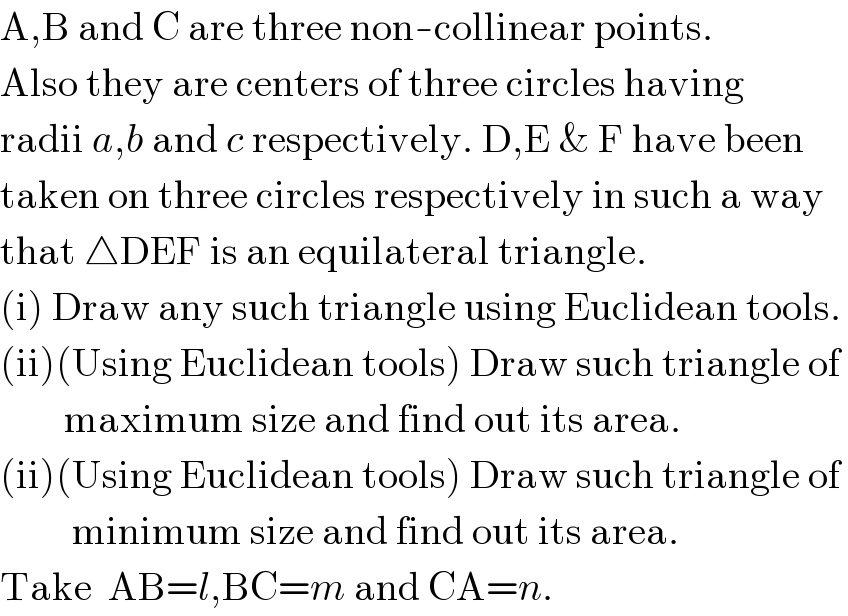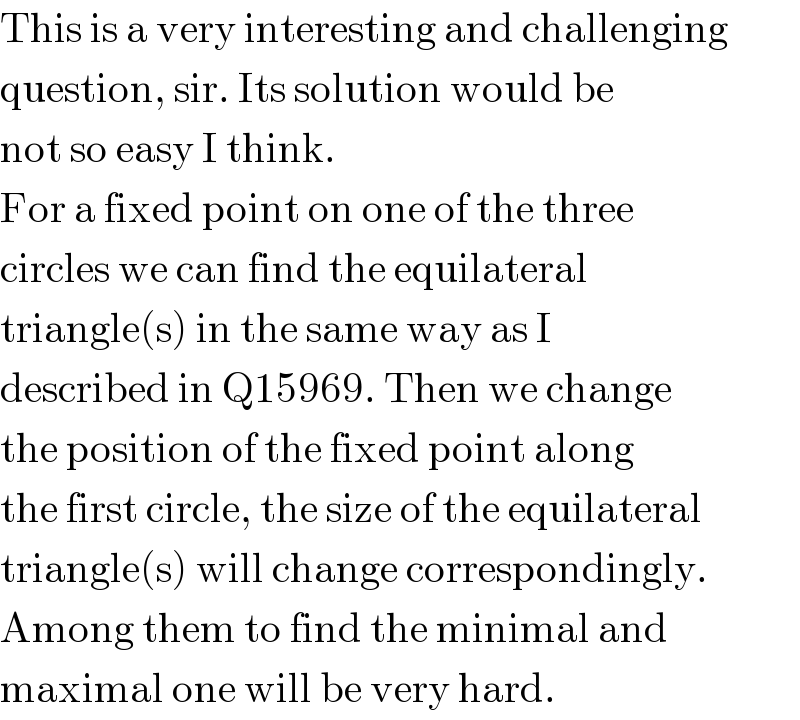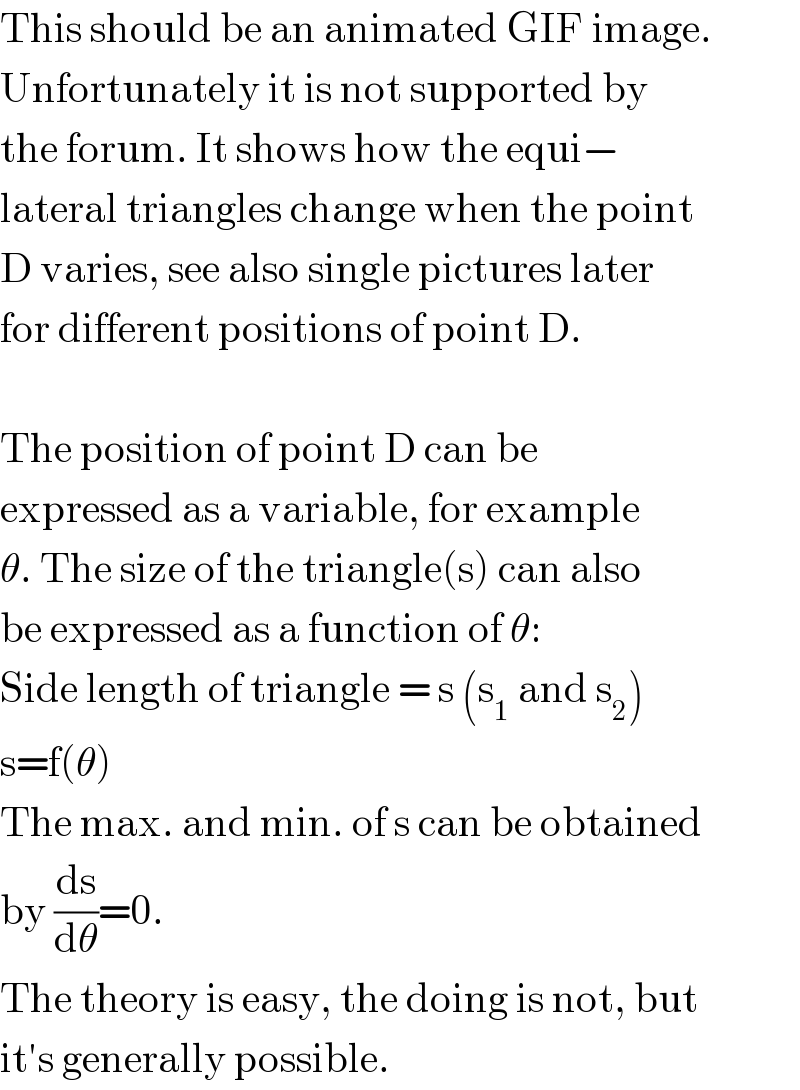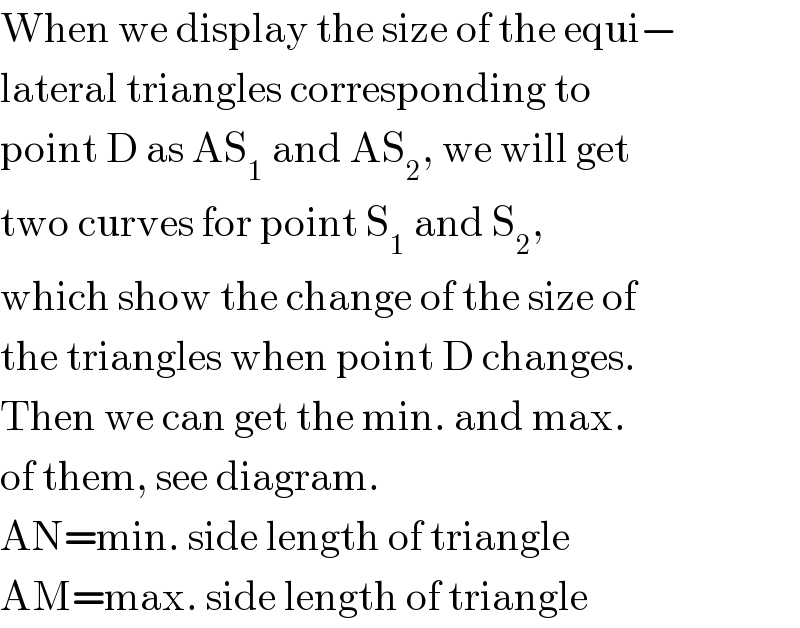
Question Number 16194 by RasheedSoomro last updated on 18/Jun/17

Commented by RasheedSoomro last updated on 18/Jun/17

$$\mathrm{A},\mathrm{B}\:\mathrm{and}\:\mathrm{C}\:\mathrm{are}\:\mathrm{three}\:\mathrm{non}-\mathrm{collinear}\:\mathrm{points}. \\ $$$$\mathrm{Also}\:\mathrm{they}\:\mathrm{are}\:\mathrm{centers}\:\mathrm{of}\:\mathrm{three}\:\mathrm{circles}\:\mathrm{having} \\ $$$$\mathrm{radii}\:{a},{b}\:\mathrm{and}\:{c}\:\mathrm{respectively}.\:\mathrm{D},\mathrm{E}\:\&\:\mathrm{F}\:\mathrm{have}\:\mathrm{been}\: \\ $$$$\mathrm{taken}\:\mathrm{on}\:\mathrm{three}\:\mathrm{circles}\:\mathrm{respectively}\:\mathrm{in}\:\mathrm{such}\:\mathrm{a}\:\mathrm{way} \\ $$$$\mathrm{that}\:\bigtriangleup\mathrm{DEF}\:\mathrm{is}\:\mathrm{an}\:\mathrm{equilateral}\:\mathrm{triangle}. \\ $$$$\left(\mathrm{i}\right)\:\mathrm{Draw}\:\mathrm{any}\:\mathrm{such}\:\mathrm{triangle}\:\mathrm{using}\:\mathrm{Euclidean}\:\mathrm{tools}. \\ $$$$\left(\mathrm{ii}\right)\left(\mathrm{Using}\:\mathrm{Euclidean}\:\mathrm{tools}\right)\:\mathrm{Draw}\:\mathrm{such}\:\mathrm{triangle}\:\mathrm{of}\: \\ $$$$\:\:\:\:\:\:\:\:\mathrm{maximum}\:\mathrm{size}\:\mathrm{and}\:\mathrm{find}\:\mathrm{out}\:\mathrm{its}\:\mathrm{area}. \\ $$$$\left(\mathrm{ii}\right)\left(\mathrm{Using}\:\mathrm{Euclidean}\:\mathrm{tools}\right)\:\mathrm{Draw}\:\mathrm{such}\:\mathrm{triangle}\:\mathrm{of} \\ $$$$\:\:\:\:\:\:\:\:\:\mathrm{minimum}\:\mathrm{size}\:\mathrm{and}\:\mathrm{find}\:\mathrm{out}\:\mathrm{its}\:\mathrm{area}. \\ $$$$\mathrm{Take}\:\:\mathrm{AB}={l},\mathrm{BC}={m}\:\mathrm{and}\:\mathrm{CA}={n}. \\ $$
Commented by RasheedSoomro last updated on 18/Jun/17

$$\mathrm{I}\:\mathrm{think}\:\mathrm{the}\:\mathrm{question}\:\mathrm{is}\:\mathrm{clear}\:\mathrm{now}. \\ $$$$\mathrm{In}\:\mathrm{question}\:\mathrm{of}\:\mathrm{Mr}\:\mathrm{Amir}\:\left(\mathrm{Behi}\right)\:\mathrm{the}\:\mathrm{circles} \\ $$$$\mathrm{were}\:\mathrm{concentric},\:\mathrm{whereas}\:\mathrm{here}\:\mathrm{circles}\:\mathrm{have} \\ $$$$\mathrm{different}\:\mathrm{centers}. \\ $$
Commented by mrW1 last updated on 20/Jun/17

$$\mathrm{This}\:\mathrm{is}\:\mathrm{a}\:\mathrm{very}\:\mathrm{interesting}\:\mathrm{and}\:\mathrm{challenging} \\ $$$$\mathrm{question},\:\mathrm{sir}.\:\mathrm{Its}\:\mathrm{solution}\:\mathrm{would}\:\mathrm{be} \\ $$$$\mathrm{not}\:\mathrm{so}\:\mathrm{easy}\:\mathrm{I}\:\mathrm{think}. \\ $$$$\mathrm{For}\:\mathrm{a}\:\mathrm{fixed}\:\mathrm{point}\:\mathrm{on}\:\mathrm{one}\:\mathrm{of}\:\mathrm{the}\:\mathrm{three} \\ $$$$\mathrm{circles}\:\mathrm{we}\:\mathrm{can}\:\mathrm{find}\:\mathrm{the}\:\mathrm{equilateral} \\ $$$$\mathrm{triangle}\left(\mathrm{s}\right)\:\mathrm{in}\:\mathrm{the}\:\mathrm{same}\:\mathrm{way}\:\mathrm{as}\:\mathrm{I} \\ $$$$\mathrm{described}\:\mathrm{in}\:\mathrm{Q15969}.\:\mathrm{Then}\:\mathrm{we}\:\mathrm{change} \\ $$$$\mathrm{the}\:\mathrm{position}\:\mathrm{of}\:\mathrm{the}\:\mathrm{fixed}\:\mathrm{point}\:\mathrm{along} \\ $$$$\mathrm{the}\:\mathrm{first}\:\mathrm{circle},\:\mathrm{the}\:\mathrm{size}\:\mathrm{of}\:\mathrm{the}\:\mathrm{equilateral} \\ $$$$\mathrm{triangle}\left(\mathrm{s}\right)\:\mathrm{will}\:\mathrm{change}\:\mathrm{correspondingly}. \\ $$$$\mathrm{Among}\:\mathrm{them}\:\mathrm{to}\:\mathrm{find}\:\mathrm{the}\:\mathrm{minimal}\:\mathrm{and} \\ $$$$\mathrm{maximal}\:\mathrm{one}\:\mathrm{will}\:\mathrm{be}\:\mathrm{very}\:\mathrm{hard}. \\ $$
Commented by RasheedSoomro last updated on 19/Jun/17

$$\mathcal{THANKS}\:\:\mathcal{SIR}! \\ $$$$\mathrm{Is}\:\mathrm{there}\:\mathrm{any}\:\mathrm{analytical}\:\mathrm{approach}\:\mathrm{for}\:\mathrm{finding} \\ $$$$\mathrm{maximum}/\mathrm{minimum}\:\mathrm{area}\:\mathrm{of}\:\mathrm{the}\:\mathrm{triangle}? \\ $$
Commented by mrW1 last updated on 19/Jun/17

Commented by mrW1 last updated on 20/Jun/17

$$\mathrm{This}\:\mathrm{should}\:\mathrm{be}\:\mathrm{an}\:\mathrm{animated}\:\mathrm{GIF}\:\mathrm{image}.\: \\ $$$$\mathrm{Unfortunately}\:\mathrm{it}\:\mathrm{is}\:\mathrm{not}\:\mathrm{supported}\:\mathrm{by} \\ $$$$\mathrm{the}\:\mathrm{forum}.\:\mathrm{It}\:\mathrm{shows}\:\mathrm{how}\:\mathrm{the}\:\mathrm{equi}− \\ $$$$\mathrm{lateral}\:\mathrm{triangles}\:\mathrm{change}\:\mathrm{when}\:\mathrm{the}\:\mathrm{point} \\ $$$$\mathrm{D}\:\mathrm{varies},\:\mathrm{see}\:\mathrm{also}\:\mathrm{single}\:\mathrm{pictures}\:\mathrm{later} \\ $$$$\mathrm{for}\:\mathrm{different}\:\mathrm{positions}\:\mathrm{of}\:\mathrm{point}\:\mathrm{D}. \\ $$$$ \\ $$$$\mathrm{The}\:\mathrm{position}\:\mathrm{of}\:\mathrm{point}\:\mathrm{D}\:\mathrm{can}\:\mathrm{be} \\ $$$$\mathrm{expressed}\:\mathrm{as}\:\mathrm{a}\:\mathrm{variable},\:\mathrm{for}\:\mathrm{example} \\ $$$$\theta.\:\mathrm{The}\:\mathrm{size}\:\mathrm{of}\:\mathrm{the}\:\mathrm{triangle}\left(\mathrm{s}\right)\:\mathrm{can}\:\mathrm{also} \\ $$$$\mathrm{be}\:\mathrm{expressed}\:\mathrm{as}\:\mathrm{a}\:\mathrm{function}\:\mathrm{of}\:\theta: \\ $$$$\mathrm{Side}\:\mathrm{length}\:\mathrm{of}\:\mathrm{triangle}\:=\:\mathrm{s}\:\left(\mathrm{s}_{\mathrm{1}} \:\mathrm{and}\:\mathrm{s}_{\mathrm{2}} \right) \\ $$$$\mathrm{s}=\mathrm{f}\left(\theta\right) \\ $$$$\mathrm{The}\:\mathrm{max}.\:\mathrm{and}\:\mathrm{min}.\:\mathrm{of}\:\mathrm{s}\:\mathrm{can}\:\mathrm{be}\:\mathrm{obtained} \\ $$$$\mathrm{by}\:\frac{\mathrm{ds}}{\mathrm{d}\theta}=\mathrm{0}. \\ $$$$\mathrm{The}\:\mathrm{theory}\:\mathrm{is}\:\mathrm{easy},\:\mathrm{the}\:\mathrm{doing}\:\mathrm{is}\:\mathrm{not},\:\mathrm{but} \\ $$$$\mathrm{it}'\mathrm{s}\:\mathrm{generally}\:\mathrm{possible}. \\ $$
Commented by mrW1 last updated on 19/Jun/17

Commented by mrW1 last updated on 19/Jun/17

Commented by mrW1 last updated on 19/Jun/17

Commented by mrW1 last updated on 19/Jun/17

Commented by mrW1 last updated on 19/Jun/17

Commented by mrW1 last updated on 19/Jun/17

Commented by mrW1 last updated on 19/Jun/17

Commented by RasheedSoomro last updated on 20/Jun/17

$$\boldsymbol{\mathrm{Oh}}\:\boldsymbol{\mathrm{Sir}},\:\boldsymbol{\mathrm{lot}}\:\boldsymbol{\mathrm{of}}\:\:\boldsymbol{\mathcal{T}}\mathcal{HANKS}!! \\ $$
Commented by mrW1 last updated on 20/Jun/17

Commented by mrW1 last updated on 20/Jun/17

$$\mathrm{When}\:\mathrm{we}\:\mathrm{display}\:\mathrm{the}\:\mathrm{size}\:\mathrm{of}\:\mathrm{the}\:\mathrm{equi}− \\ $$$$\mathrm{lateral}\:\mathrm{triangles}\:\mathrm{corresponding}\:\mathrm{to} \\ $$$$\mathrm{point}\:\mathrm{D}\:\mathrm{as}\:\mathrm{AS}_{\mathrm{1}} \:\mathrm{and}\:\mathrm{AS}_{\mathrm{2}} ,\:\mathrm{we}\:\mathrm{will}\:\mathrm{get} \\ $$$$\mathrm{two}\:\mathrm{curves}\:\mathrm{for}\:\mathrm{point}\:\mathrm{S}_{\mathrm{1}} \:\mathrm{and}\:\mathrm{S}_{\mathrm{2}} , \\ $$$$\mathrm{which}\:\mathrm{show}\:\mathrm{the}\:\mathrm{change}\:\mathrm{of}\:\mathrm{the}\:\mathrm{size}\:\mathrm{of} \\ $$$$\mathrm{the}\:\mathrm{triangles}\:\mathrm{when}\:\mathrm{point}\:\mathrm{D}\:\mathrm{changes}. \\ $$$$\mathrm{Then}\:\mathrm{we}\:\mathrm{can}\:\mathrm{get}\:\mathrm{the}\:\mathrm{min}.\:\mathrm{and}\:\mathrm{max}. \\ $$$$\mathrm{of}\:\mathrm{them},\:\mathrm{see}\:\mathrm{diagram}. \\ $$$$\mathrm{AN}=\mathrm{min}.\:\mathrm{side}\:\mathrm{length}\:\mathrm{of}\:\mathrm{triangle} \\ $$$$\mathrm{AM}=\mathrm{max}.\:\mathrm{side}\:\mathrm{length}\:\mathrm{of}\:\mathrm{triangle} \\ $$
Commented by RasheedSoomro last updated on 20/Jun/17

$$\mathrm{One}\:\mathrm{thing}\:\mathrm{to}\:\mathrm{understand}: \\ $$$$\mathrm{S1}\:\mathrm{and}\:\mathrm{S2}\:\mathrm{are}\:\mathrm{points}\:\mathrm{and}\:\mathrm{also}\:\mathrm{lengths}? \\ $$
Commented by mrW1 last updated on 20/Jun/17

$$\overline {\mathrm{AS}_{\mathrm{1}} }=\mathrm{length}\:\mathrm{s}_{\mathrm{1}} \\ $$$$\overline {\mathrm{AS}_{\mathrm{2}} }=\mathrm{length}\:\mathrm{s}_{\mathrm{2}} \\ $$
Commented by mrW1 last updated on 20/Jun/17

Commented by mrW1 last updated on 20/Jun/17

Commented by RasheedSoomro last updated on 21/Jun/17

$$\boldsymbol{\mathcal{TH}\alpha{nks}}\:{for}\:{your}\:{deeply}\:{involvement} \\ $$$${in}\:{my}\:{question}! \\ $$$$\boldsymbol{\mathcal{TH}\alpha{nks}}\:{for}\:{so}\:{much}\:{labour}! \\ $$
